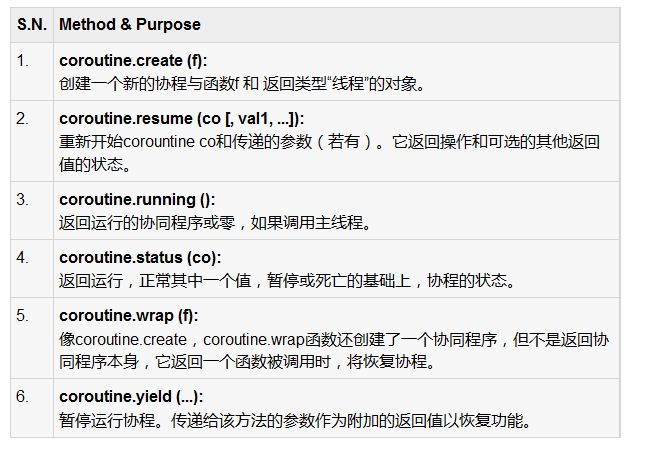萬盛學電腦網 >> 網絡編程 >> 編程語言綜合 >> 舉例詳解Lua中的協同程序編程
舉例詳解Lua中的協同程序編程
這篇文章主要介紹了Lua中的協同程序編程,是Lua入門學習中的基礎知識,需要的朋友可以參考下
協同程序是協同的性質,可以把兩個或更多的方法以可控制的方式執行。隨著協同程序,在任何給定的時間,只有其協同程序運行之一,這在運行協同程序只能暫停其執行時,明確要求暫停。
上述定義可能看起來模糊。來告訴它更清楚,假設我們有兩個方法,一個主程序方法和協同程序。當我們使用恢復功能調用協程,其開始執行,當我們調用yield功能,暫停執行。再次同協程可以繼續從它被暫停的另一個恢復功能調用執行。這個過程可以繼續,直到執行了協程的結束。
協同程序可用的功能
下表列出了在Lua協同程序及其相應的使用所有的可用功能。

例子
讓我們看一個例子就明白了協程的概念。
代碼如下:
co = coroutine.create(function (value1,value2)
local tempvar3 =10
print("coroutine section 1", value1, value2, tempvar3)
local tempvar1 = coroutine.yield(value1+1,value2+1)
tempvar3 = tempvar3 + value1
print("coroutine section 2",tempvar1 ,tempvar2, tempvar3)
local tempvar1, tempvar2= coroutine.yield(value1+value2, value1-value2)
tempvar3 = tempvar3 + value1
print("coroutine section 3",tempvar1,tempvar2, tempvar3)
return value2, "end"
end)
print("main", coroutine.resume(co, 3, 2))
print("main", coroutine.resume(co, 12,14))
print("main", coroutine.resume(co, 5, 6))
print("main", coroutine.resume(co, 10, 20))
當我們運行上面的程序,會得到下面的輸出。
代碼如下:
coroutine section 1 3 2 10
main true 4 3
coroutine section 2 12 nil 13
main true 5 1
coroutine section 3 5 6 16
main true 2 end
main false cannot resume dead coroutine
上面的例子是做什麼?
如之前所提到的,我們使用恢復功能的動作開始,並產生函數來停止操作。此外,可以看到有由協程恢復功能接收多個返回值。這裡將解釋上面的程序每一個步驟,使之清楚。
首先,我們創建了一個協同程序,並把它分配給變量名合作和協同程序需要在兩個變量作為參數。
當我們稱之為第一恢復功能,值3和2分別被保持在臨時變量value1和value2,直到協程的結束。
為了理解這一點,我們已經使用了tempvar3初始化為10,它被由協程的後續調用更新為13和16,因為值1被保留為3,整個協同程序的執行。
第一個coroutine.yield返回兩個值4和3 是由更新輸入參數3和2,yield語句得到了恢復函數。它還接收協程執行的真/假狀態。
關於協程的另一件事是如何恢復調用下一參數寫成的照顧,在上述的例子; 可以看到,coroutine.yield分配變量接收到下一次調用參數,它提供做新業務與現有參數值之間的關系的一種強有力的方式。
最後,一旦在協同程序的所有語句執行時,後續調用將返回false,並且“不能恢復死協同程序”語句作為回應。
另一個協程的例子
讓我們來看一個簡單的協同程序返回一個數字,從1到5 yield函數恢復功能。它創建協同程序,如果沒有則恢復現有的協程。
代碼如下:
function getNumber()
local function getNumberHelper()
co = coroutine.create(function ()
coroutine.yield(1)
coroutine.yield(2)
coroutine.yield(3)
coroutine.yield(4)
coroutine.yield(5)
end)
return co
end
if(numberHelper) then
status, number = coroutine.resume(numberHelper);
if coroutine.status(numberHelper) == "dead" then
numberHelper = getNumberHelper()
status, number = coroutine.resume(numberHelper);
end
return number
else
numberHelper = getNumberHelper()
status, number = coroutine.resume(numberHelper);
return number
end
end
for index = 1, 10 do
print(index, getNumber())
end
當我們運行上面的程序,會得到下面的輸出。
代碼如下:
1 1
2 2
3 3
4 4
5 5
6 1
7 2
8 3
9 4
10 5
往往有協同程序與多道程序語言的線程的比較,但要明白,協同程序線程有類似的功能,但只有一次執行,並不會執行兼任。
我們控制程序的執行順序,以滿足與提供暫時保留某些信息的需求。使用全局變量與協程,提供了協同程序更加靈活。
- 上一頁:詳解Lua中的元表概念
- 下一頁:Lua中的文件I/O操作教程



